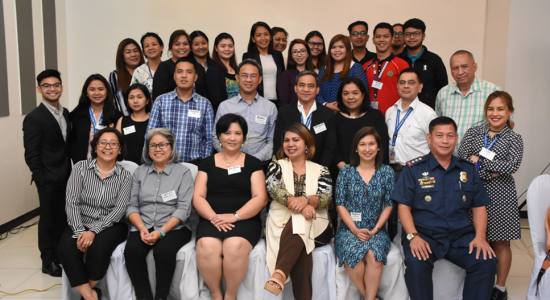
The Development Academy of the Philippines presented the results of two evaluation studies conducted on two major projects of the Department of Health in the MIMAROPA (Mindoro, Marinduque, Romblon and Palawan) Region. In an event held a few months back at the Goldland Millenia Suites in Pasig City, the research team presented the results and held a workshop to validate the findings with key stakeholders, and come up with management’s response to the recommendations.
The first presentation laid out the key findings in the assessment of the Municipal Health Leadership Governance Program (MLGP) participants in MIMAROPA. Dorothea Boy-Navarro of the DAP’s Sustainable Human Development Program described the survey and focus group discussions undertaken to elicit information on the program. It was found out that the MLGP benefitted the communities in the five provinces of MIMAROPA by increasing access to health services. It also gave plenty of help to the mayors of the said provinces because they gained a better understanding of the health systems instead of depending solely on their municipal health officers.
Community-based drug rehabilitation
The bigger study done commissioned to DAP was the evaluation of five community-based drug treatment and rehabilitation (CBDTR) modalities in MIMAROPA. This was after President Rodrigo Duterte’s declaration of a “war on drugs” in 2016 and the subsequent drug demand reduction effort tagged “Tokhang,” which created a surge in drug surrenderers who needed recovery services.
The DAP’s Jo-Ann de Belen, lead investigator for the study, mentioned that amidst the complex situations that emerged in the drug war, the DOH in MIMAROPA responded quickly by fielding five “experimental” modalities of community-based drug rehabilitation, one in each province in the region. The study revealed that at least one, particularly the Palawan model, adopted the therapeutic community method in a non-facility community setting. Part of the success of the Palawan model is attributed to strong LGU commitment, allocation of resources, partnership with local stakeholders, and formal executive mandates.
Development of scorecard
The study also proposed the development of a scorecard for the CBDTR ecosystem. Dr. Elmer Soriano explained that the scorecard’s purpose was to enable local chief executives to monitor their community-based drug rehabilitation performance and to enable them to make evidence-based decisions.
The DAP research team, led by Ms. De Belen and Dr. Soriano, was composed of Reuel Hermoso, Enrico Caja Marietta Legaspi, Dr. Chester Cabalza, Mariel Uy, Rhia Capinig and Marites Solomon. External experts included Dr. Regina Hechanova of the Philippine Association of Psychologists, Dr. Erlidia Llamas-Clark of UP-PGH, and Janet Paredes of the National Acupuncture and Detoxification Association.
As an offshoot of the studies, the DOH requested the DAP to assist in the drafting of a “Minimum Standards for Community-Based Drug Recovery and Support Services” and a compendium of evidence-based CBDTR modalities that can be implemented at the barangay level. In addition, the DAP is co-convening, together with Civika and Galing Pook Academy, the Center for Drug Policy: A Consortium. This will involve state universities and colleges (SUCs), non-governmental organizations and other academic, government and private institutions. – Paolo Serraon




